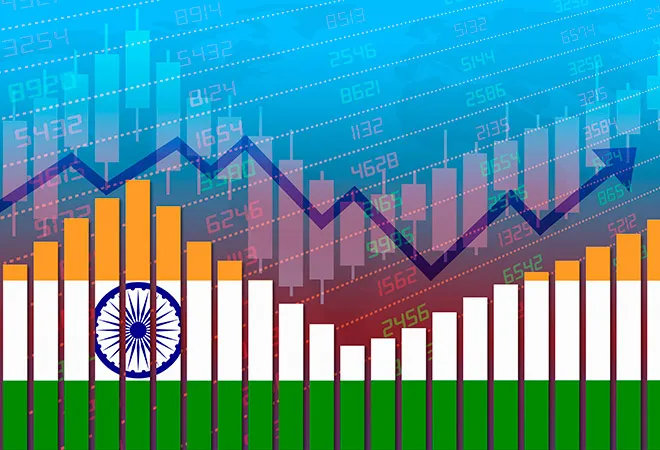The liberalization regime, which began in 1991 and ended in 2021, has been in place for 30 years. 1991 was a watershed point in India’s post-independence history, fundamentally altering the character of the economy.
In 1991, a significant balance of payments problem precipitated a catastrophic economic downturn. In response, India’s economic establishment embarked on a multi-pronged reform plan aimed at repairing the country’s macroeconomic balance sheet and re-igniting development.
Three decades later, the country is facing yet another major challenge in the form of the COVID-19 epidemic. While the two crises have dramatically different content and organization, their severity is entirely equivalent.
The Importance of the Reforms of 1991:

India’s Post-1990 Economic Strategy
- It dismantled the vast network of controls and permits that dominated the economic system, redefining the state’s role as a facilitator of economic transactions and a neutral regulator rather than the primary provider of goods and services, and leading to a shift away from an import substitution regime and full integration into the global trading system.
Effect of Reforms
- India became known as one of the fastest growing emerging markets in the first decade of the twenty-first century.
- The 1991 reforms energized Indian businesses, provided consumers with unprecedented choice, and transformed the Indian economy, resulting in a significant reduction in poverty for the first time in the country’s history.
Comparing 1991 Crisis With 2021 :-
High Fiscal Deficit
- 1991 Crisis: Excess domestic demand sucked in imports and widened the current account imbalance, resulting in the 1991 crisis (CAD).
- A lack of confidence resulted in a money drain, and financing CAD necessitated a substantial reduction in reserves.
- 2021 Crisis: The pandemic-induced shutdown in 2021 brought the wheels of economic activity to a standstill, resulting in a significant economic decline.
- As a result of the pandemic’s disruption, output has collapsed, resulting in a drop in demand.
- It is reasonable to expand the budget deficit in the face of a drop in demand. Last year, the administration allowed the fiscal deficit to rise to 9.6%.
Macroeconomic Situation
- 1991 Crisis: To avoid a national debt default, India had to guarantee tones of gold. Then we were on the verge of running out of foreign currency to pay for vital goods.
- 2021 Crisis: The economy is currently contracting at a fast rate, with the federal government unable to meet its tax obligations to the states.
- We have ran out of work for our legions of unemployed people today, and poverty is rising after decades of reduction.
Criticism of the Reform
- 1991 Reforms: The 1991 reform package was heavily criticized for being dictated by the World Bank and the International Monetary Fund (IMF).
- In addition, several measures have been characterized as a surrender to capitalists.
- Reforms in 2021: A centralized approach to reforms may no longer be feasible. Three farm laws have sparked outrage, as seen by the protests.
Way Forward :-

Sustaining Public Expenditure: In the short term, maintaining government spending is critical to recovering growth.
At the moment, increased public spending is extremely desirable in order to provide more funding for vaccination and coverage. Demand for the MGNREGA has increased, indicating that it is proving to be a useful safety net.
- In addition, a credible route for deficit reduction over the next three years must be established, as well as income projections that are more realistically set.
- Mutually Supportive Reforms: The 1991 changes were successful because they were built around a core package of reforms that were mutually supportive.
- As a result, instead of a large list of reforms, a more strategic approach is required, focusing on the most crucial reforms that must be implemented promptly.
- In this setting, reforms are required in the electricity sector, banking system, governance systems, and even agricultural marketing.
- Improving Investment Climate: Increasing your investment Investment is an important source of aggregate demand and economic growth. In this situation, perceptions of economic possibilities are critical.
- The policy framework must encourage entrepreneurs to take risks by encouraging new investments.
- Non-economic elements such as social cohesiveness and a tranquil environment are also important.
- The administration must take action on all of these fronts immediately.
- Maruti Model of Disinvestment: The government should cut its stake in each activity, including banks, to 26 percent and sell it to strategic partners, as it did with the Maruti disinvestment following 1991 reforms.
- In this framework, PSUs like as Air India, BPCL, and Concor might be sold over the next six months, with a pledge to divest two dozen PSUs every year for the following five years under the “Maruti model.”
- The government would be able to generate billions of rupees in investible surplus as a result of this.
- Multi-stakeholders Approach: Today’s reforms need a lot more deliberation and consensus-building. The federal government must collaborate with state governments and involve many stakeholders who may be affected by reform choices.
Conclusion :-
- The changes of 1991 aided the economy in avoiding a crisis and then blooming. It’s past time to lay out a credible new reform strategy that would not only restore GDP to pre-crisis levels, but also assure growth rates that are greater than they were before the epidemic began.
